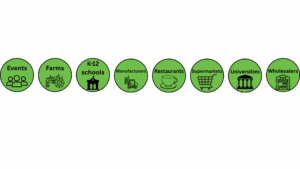One million pounds of food ends up in the Franklin County Landfill every day. Much of it is produce that’s rotting, prepared food that’s no longer safe to eat or shelf-stable products past their sell-by date. With proper planning, this food could be saved and help support the 1-in-7 Franklin County residents who are food insecure.
WHO CAN DONATE?
Individuals, food businesses, offices and schools can all play a role in getting leftover food to people in need.
 GET INVOLVED WITH FOOD RESCUE AS AN INDIVIDUAL
GET INVOLVED WITH FOOD RESCUE AS AN INDIVIDUAL
Hundreds of organizations collect and distribute food across the county. Many religious institutions run food pantries, and they often rely on volunteers. These are great options for individuals or groups looking to make a difference in a specific community. Try googling your community’s name and “food pantry.”
There are several powerhouse organizations that connect businesses with excess food to nonprofits that give it away. Volunteers help get millions of pounds of food to people in need. Check out these organizations:
- Columbus Food Rescue: Volunteers work on their own schedule to pick up donations and deliver them to a local organization.
- Ro’s Kitchen: Volunteers sign up for produce prep or cooking shifts to transform fresh produce into meals for those who can’t cook for themselves.
- Mid-Ohio Food Collective: A variety of opportunities are available for individual or group volunteers at Ohio’s largest Feeding America food bank.
- Rescuing Leftover Cuisine: Volunteers work on their own schedule to pick up donations and deliver them to a local organization.
 DONATE FOOD FROM YOUR FOOD BUSINESS OR WORKPLACE
DONATE FOOD FROM YOUR FOOD BUSINESS OR WORKPLACE
Any business that handles food can donate it if food safety standards are followed. This includes a wide variety of establishments, such as:
- Caterers
- Colleges
- Corporate cafeterias offices that cater meetings
- Event venues
- Farmers’ markets
- Farms
- Food manufacturers
- Grocery and convenience stores
- Hospitals
- K–12 schools
- Restaurants
- Sports arenas
- Trucking distribution centers
- Universities
Donating food can help food businesses become more efficient. Businesses that begin donating excess food often end up adjusting menus, food preparation and volumes to reduce overproduction and costs. Federal tax deductions provide an additional incentive to donate food.
HOW CAN A BUSINESS DONATE FOOD LEFT OVER FROM AN EVENT?
As an event organizer, familiarize yourself with what can and cannot be donated and whether items need to be kept hot or cold. This may inform you on what to order and will help you plan how food needs to be packaged and stored.
Identify a receiving agency to accept your food donation. Columbus Food Rescue and Rescuing Leftover Cuisine are organizations that can help you connect with a community pantry with a need for the type of food you will be donating. Not all pantries can accept all types of food, and some are only open on select days.
On the day of the event, prep the donation based on any directions provided by the rescue agency and you’re done! Maintain records of what and how much was donated if you plan on claiming a federal tax deduction.
_______________________________
 DONATE FOOD FROM YOUR SCHOOL
DONATE FOOD FROM YOUR SCHOOL
Schools and institutions can donate food just like any business that handles food and would follow the same steps provided above.
Before donating food to an outside organization, schools can set up Share Tables
to help hungry kids get food to fuel their day and help reduce wasted food. Share Tables allow children to return whole food or beverage items they choose not to eat during a meal service period. These items are then available to other children who may want additional servings.

